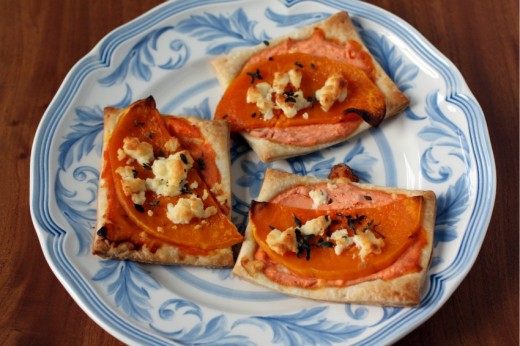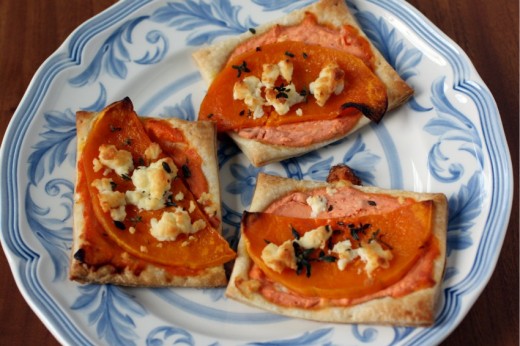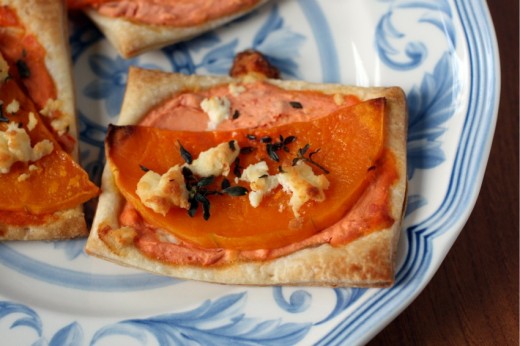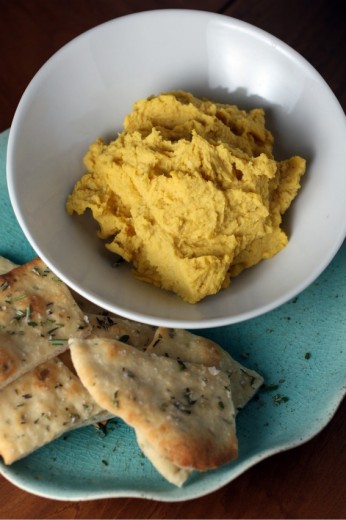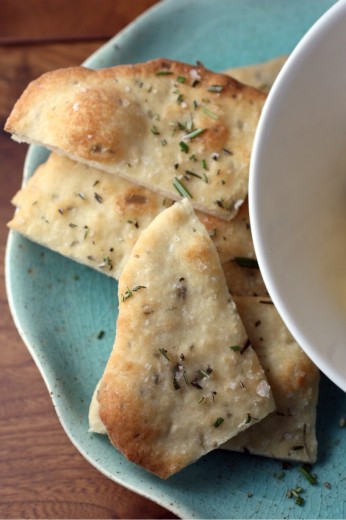You may not agree with me but I think the tendency to hang on to things is genetic. I am a purger. Randy is a saver. (Not hoarder. No cat skeletons hiding under mountains of garbage in our house.) My parents have barely held on to anything from out childhoods except for photographs. Randy’s parents periodically send us packages containing things (books, art work, letters) from his youth. My parents purge and Randy’s save.
There is no time when those differences are clearer than when you move. Each time I have moved, I have gotten rid of a tremendous amount of stuff. I basically eye each thing I am about to put in a box and ask myself, “Do I want to pack this, only to have to unpack it?” Many times the answer is no. So off to Goodwill it goes. Randy has a harder time with this process. He often can’t give things away because he either “paid good money for it” or because the thing in question has sentimental value. I might be thinking in particular of a hideous green and yellow jersey that, while I have not successfully persuaded him to toss, I have successfully persuaded him he should not wear.
This last time, for our move to Oakland, we had movers who packed us up. This incredible service was paid for by his company and I can honestly say I’m never doing it any other way. You basically just live your life in your house with all your stuff until the moving day and then bam! a team of professionals descends on you and packs everything in sight. They wrap all the dishes and glassware, have special boxes for hanging clothes, and label everything clearly. I’ve heard some people say that these types of teams even pack the garbage in the garbage can but that was not our experience.
Having this service was an incredible luxury with one caveat. Because I wasn’t packing each box myself, or loading each thing on a truck, quite a bit slipped through the cracks. Once we got to Oakland, they put all the boxes and furniture in the right rooms but we were responsible for the unpacking part. About 100 times, I asked, “Why did this make it here?” We had done a purge before they arrived but there is no purge like the one where you look hard at something and ask yourself whether or not it should make the trip.
All this to say that we have this little basket with a top that I would probably have donated to Goodwill sitting beside our couch. It acts as a mini coffee table for Randy’s watching-tv-glass-of-water or bourbon. Sometimes he remembers to bring that glass of water back over to the sink at night and sometimes he does not. Recently, the boys were horsing around in that room and knocked over the leftover water (which, thankfully, was water and not bourbon) and as I was cleaning up, I realized that there were food magazines stashed away in that basket. Not just food magazines, but a few copies of Gourmet from 2007.
Now, we all miss Gourmet, right? I know I do. I have years and years of recipes cut our from that magazine along with Bon Appétit and Food & Wine. Paging through the issues that I had left, I found recipes for things that I wanted to make immediately. One of which was this onion tart. I make a great Pissaladière, which this tart resembles but with some intriguing differences. The base is a yeasted tart dough rather than puff pastry, it features a slick of mustard on the bottom of the crust, fennel seeds sautéed with the onions, and a topping of Parmesan cheese. I had the kindergarten moms come for dinner last week and this tart swiftly went on the menu.
I love a recipe that can be made for lunch, brunch, dinner, or an appetizer and this one fits the bill. I thought the dough was incredibly sticky and I might have cursed Gourmet a few times (I love you! I miss you! I hate you!) but in the end this was an incredibly fragrant and powerfully flavored tart. Unlike a Pissaladière, the crust is very neutral tasting but with a bit of crunch, so the onions are really the star of the show. Just that little bit of cheese is a beautiful balance of savory to the gorgeous sweetness of the onions and the mustard gives you a nice hit of spice. I let the tart cool to room temperature and then cut it into small pieces, but it could easily but cut into nice wedges for more of a main course.
UPDATE 5-25-13: I had wedges of this tart left over. I wrapped them in foil and stored them in the fridge. Days later, I reheated them, in a 250º oven, and the tart tasted as good as the day it was made.
Two Years Ago: Spiced Cocktail Nuts
Three Years Ago: Lighter Fettucine Alfredo, Curried Tofu and Avocado Dip, Giant Chocolate Cake
Four Years Ago: Roasted Asparagus with a Poached Egg, Ginger Ice Cream, Tofu and Cucumber Salad with Spicy Peanut Sauce
Onion Tart with Mustard and Fennel
Adapted from Gourmet
Serves about 8 as an appetizer
I like to slow cook my onions in a cast iron skillet. I find the evenness and the retention of the heat works really well. I would avoid a non-stick pan as it can take longer for them to caramelize. The round of parchment helps keep the onions really moist and takes them to a jammier texture but you can omit that step. Just make sure the heat is nice and low, stir them occasionally, and allow them at least an hour (or more) to achieve their dreamy potential.
2 ¼ teaspoons active dry yeast (a ¼-ounce package)
½ cup warm water (105-115°F)
1½ to 1 ¾ cups all-purpose flour
1 large egg
1/3 cup plus 1 tablespoon extra-virgin olive oil, divided
2 ½ teaspoons salt, divided
2 teaspoons fennel seeds
3 pound yellow onions, halved and thinly sliced
1 tablespoon Dijon mustard
½ cup freshly grated Parmigiano-Reggiano
Stir together yeast and warm water in a small bowl and let stand until foamy, about 5 minutes. (If mixture doesn’t foam, start over with new yeast.)
Put 1 ½ cups flour in a medium bowl, then make a well in center of flour and add yeast mixture to well. Stir together egg, 1 tablespoon oil, and 1 ½ teaspoons salt with a fork. Add egg mixture to yeast mixture and mix with a wooden spoon or your fingertips, gradually incorporating flour, until a soft dough forms. Transfer dough to a floured surface and knead, working in additional flour (up to ¼ cup) as necessary, until smooth and elastic, about 5 minutes. (DT: I used a lot of flour on my board to keep the dough from sticking.) Transfer dough to an oiled bowl and turn to coat. Cover with plastic wrap and let rise in a draft-free place at warm room temperature until doubled, 1 to 1 ½ hours.
While dough rises, heat remaining 1/3 cup oil in a 12-inch heavy skillet over medium-high heat until it shimmers, then sauté fennel seeds until a shade darker, about 30 seconds. Stir in onions, remaining teaspoon salt, and 1/2 teaspoon pepper, then reduce heat to medium-low and cover onions directly with a round of parchment paper. Cook, stirring occasionally, until onions are very tender and golden brown, 1 to 1¼ hours.
Preheat oven to 375°F with rack in middle.
Knead dough gently on a floured surface with floured hands to deflate. Transfer dough to a heavy baking sheet lined with parchment paper. Pat out dough into a roughly 15- by 12-inch rectangle, turning up or crimping edge, then brush mustard evenly over dough, leaving a ½-inch border around edge. Spread onions evenly over mustard, then sprinkle evenly with cheese.
Bake tart until crust is golden brown, 30 to 35 minutes. Cut into 2-inch squares or diamonds and serve warm or at room temperature.
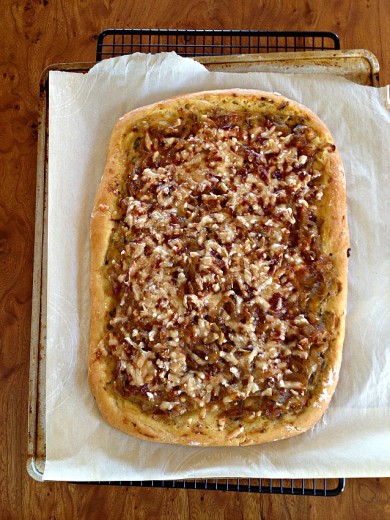

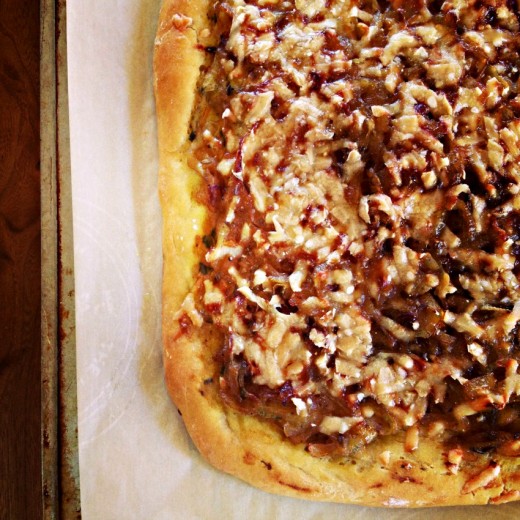

 Share
Share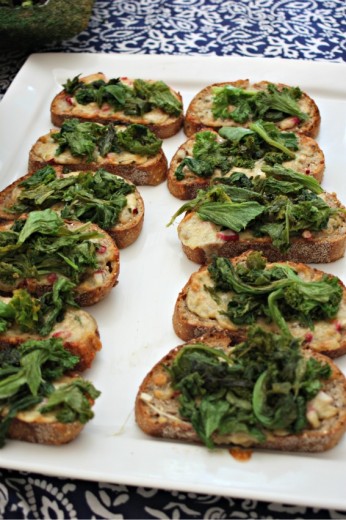
![IMG_0223[1]](http://danatreat.com/wp-content/uploads/2012/05/IMG_02231-520x520.jpg)
![IMG_0224[1]](http://danatreat.com/wp-content/uploads/2012/05/IMG_02241-520x520.jpg)
